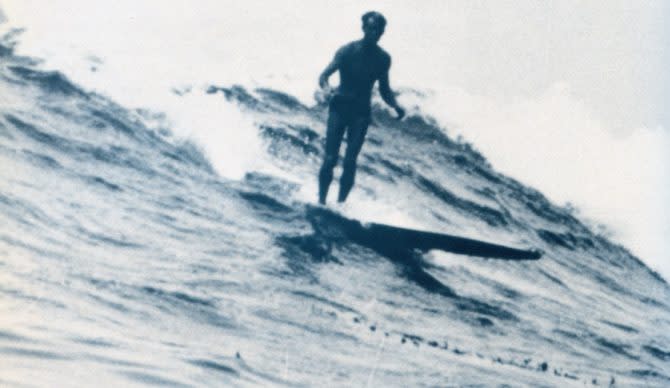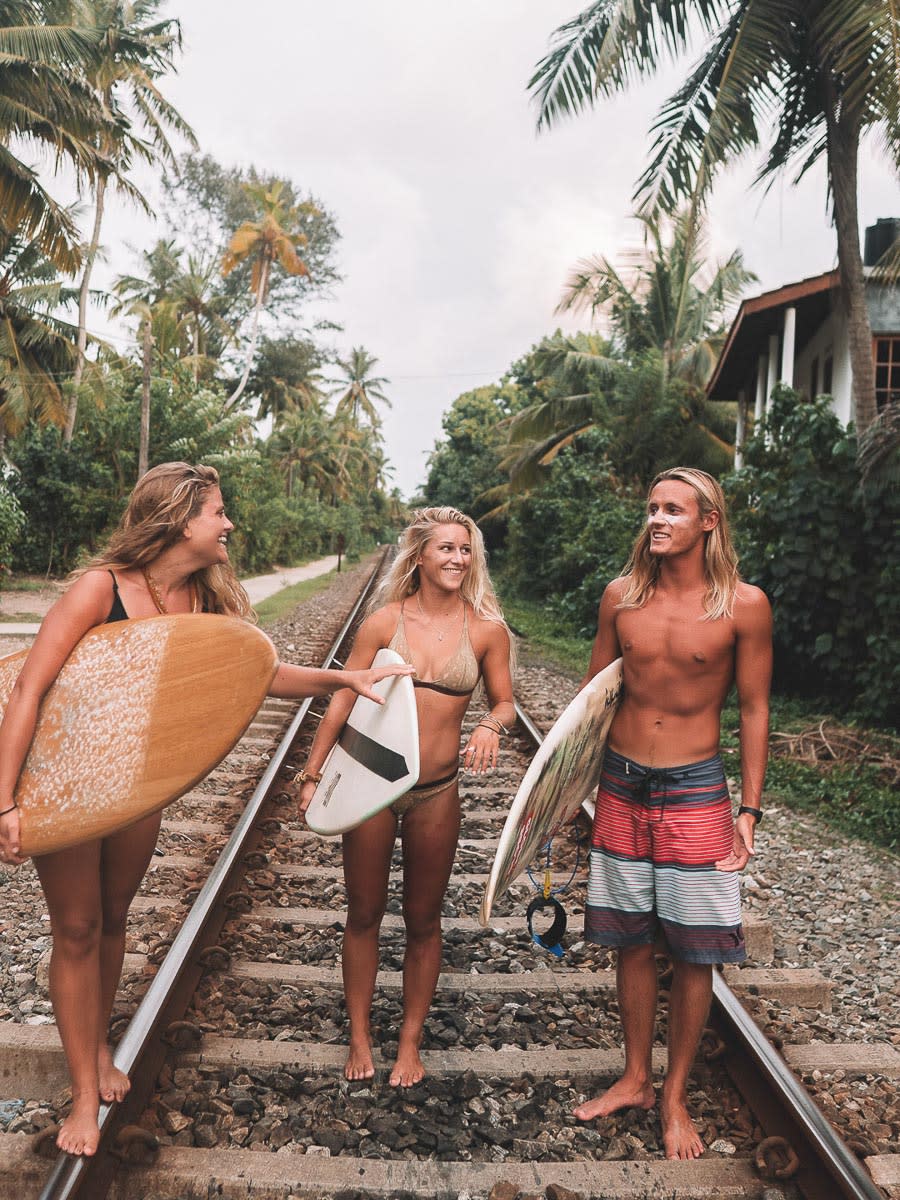
Surfing and its complex history — a guide
June 30, 2025Surfing is more than just a sport—it’s a way of life, deeply intertwined with culture, adventure, and nature. But where did it all begin? From ancient Polynesia to modern wave pools, the history of surfing is a fascinating ride through time. Let’s paddle into the origins, evolution, and innovations that have shaped this incredible sport.
Surfing doesn’t require more than a board, some good waves and the spirit of adventure. It is driven by fun and adrenaline, all while connecting with nature, similar to yoga or a hike in the forest.
But where or how did surfing start? That seems more complex than expected because surfing, or a form of body surfing, has been practised for many centuries. Even back in a time, when no form of media or photography existed. In other words: the moment humankind started swimming, is most likely the moment we started surfing too.
What is surfing?
Surfing got its name from the renowned artist John Webber, who spotted native Hawaiians in the Bay of Kealakekua doing such activity. Its origin in English means “wave crest, break or swell”.
Surfing history around the world
PERU
Evidence has been secured in Peru suggesting that riding a wave sitting on a vessel called ‘Chimu’ has been hundreds of years ago. The Inka has also been surfing during 1590 as documented in a journal.
POLYNESIA
Surfing is said to be a major part of ancient Polynesian culture, which predates the time of contact with European cultures. Cave paintings from the 12th Century show people gliding on waves.
HAWAII BEFORE EUROPEAN INFLUENCE
Polynesians brought surfing to Hawaii and the sport received a lot of attention from Hawaiians. It was not only seen as a sport but also as an important part of the religion. The tree choice for shaping a board was vital. Religious rituals were practised during the shaping of each board. These served as protection and to secure the gods' goodwill. Even though everyone was a part of surfing there was a strict rule system that regulated who could surf on which spot.
Hawaii after contact and surfing in the US
The first written evidence of the history of surfing was found in James Cook's diary. He was not only the European captain who documented new lands like Australia and Hawaii but also the sport that won the hearts of millions.
After Christian missionaries took over Hawaii, the Hawaiians had to change a lot. Surfing was not allowed anymore because of nudity. They had to visit the church frequently and kids had to undergo Christian education. Surfing sadly lost its strong influence in this time - but never vanished completely.
Surfing was first demonstrated in the United States in 1885 by three teenage Hawaiian Princes who surfed the mouth of the San Lorenzo River in Santa Cruz on redwood boards. In 1907 George Freeth demonstrated surfing as a publicity stunt at the Huntington Beach pier.
But surfing as such really did not recover until the early 20th century with a group of teenagers known as the ‘Beach Boys of Waikiki’. One of them was George Freeth. He moved to California, became a lifeguard and started to spread the word about surfing.
In 1912 Duke Kahanamoku or ‘The Duke’ who was one of the best surfers in Hawaii won the Olympic 100-meter freestyle contest, because of the crawl technique he had copied from surfing. After his success, he travelled around the world introducing surfing in all regions where conditions made it possible.
When Hawaii joined the US as the 51st state, tourism on the islands boomed as never before.
Surfing history in South America
Around 4,000 years ago, fishermen from the Moche and Chimú cultures mastered the art of riding waves on ‘caballitos de tortora’ (reed fishing rafts). The earliest photographs of surfers at Chorrillos in Lima date back to 1914. In 1942, Carlos Dogni Larco brought his first board from Hawaii and turned his friends on to the sport, founding Club Waikiki.
Surfing history in Australia
In 1910, surfing was demonstrated with a 10 ft (300 cm) surfboard shaped in Waikiki Beach, Hawaii. Tommy Walker had purchased it for 2 dollars.
1914-15 surfing was demonstrated in Australia by the swimming legend Duke Kahanamoku as part of his tour. His board is now displayed in Sydney in the Freshwater Life Saving Club.
Surfing history in the UK
Four Australian teenagers introduced surfing in the UK in 1929. Today, the sport has a small but significant following, and Cornwall is considered a hotbed of surfing in the UK.
Surfing gear evolution: The Evolution of the Surfboard and Invention of the First Wetsuit
Not only surfing itself but also the tools changed a lot – especially in recent years. A big change happened when the round nose and laminated fins covered with fibreglass got introduced. These made unbelievable manoeuvres possible.
Up to the early 20th century, surfboard design was relatively simple. Boards were made out of planks cut from Willi Willi, Ula, Koa and Redwood trees, all native to the Pacific islands. These could weigh as much as 150 pounds. It was kind of like riding a wave on a dining room table. To keep the wood smooth and a little water-resistant they were treated with coral and then stained with bark and charcoal before finishing with a coat of nut oil.
Surfboard designers eventually figured out that more aerodynamic surfing came with a board that was hollow, light and water-repellent. In 1926, surfer and board maker Tom Blake changed things when he fashioned a hollow surfboard. It was 15 feet (4.6 m) long, weighing 100 pounds (45.4 kg). Its design made it much faster than traditional surfboards. Blake's board became the first mass-produced surfboard. He also installed the first rudders, or ‘fins’ on surfboards in 1935.
The big invention was the fibreglass board and polyurethane foam that would rule out the use of heavy wood. Board maker Pete Peterson made the first fibreglass board in 1946, built around a redwood stringer (a centreboard), then covered and sealed it with fibreglass tape.
The first wetsuit on the other hand was invented by Jack O’Neill in the early 50s.
The Polystyrene surfboard in the UK was invented by Reginald Sainsbury of Wilcove in the early 1960s. Four young Australians sailed on the SS Arcadia from Sydney to Tilbury docks in 1962 and crammed what are thought to be the first fibreglass surfboards ever seen in Britain into London taxis and onwards to Cornwall.
In the 70s, the Australian Simon Anderson invented today's 3-fin-system on the shortboard. This was the last eminent step that led to the shortboard as we know it today.
The Surfer Jack O'Neill and his sons fashioned the first leg ropes between 1971 and 1973 out of pliable, flexible surgical tubing. One end got attached to the board’s tail with an embedded plug, and the other hung as an anklet on the surfer’s leg.
The big surf boom happened. It is said to have been mainly fuelled by the increased availability of surfboards. But wetsuits also became better, making surfing in cold waters possible and smaller boards provided opportunities for more radical turns and manoeuvres. Hollywood movies made surfing popular in areas far away from water and led to a big increase in surf travel, a whole new lifestyle.
Current surfboard categories

Fish board/ Shortboard (for short, flat waves)
Mini malibu (long and wide, the modern incarnation of the longboard and good for intermediate surfers)
Longboard (perfect board for slow rolling waves and playful elegance on the wave)
Longboard gun (combines the lightness of a shortboard with the length of a longboard, allowing the surfer to tackle big waves)
Surfing at Lapoint Surfcamp

Lapoint provides a unique opportunity for you to try out lots of different boards in all shapes and sizes. This gives you the option to find the right board for you before being unsure and ending up getting one that is not the right fit for you. Feel free to head to our blog post about finding YOUR board.
Surfing in this day and age
Artificial waves
The newest advancement in the surfing industry is the development of artificial waves, an advance that could revolutionize and further strengthen the sport by making it available to millions of people who permanently live far from the coast.
ISA
The International Surfing Association (ISA) is responsible for amateur surfing, holding world championships by country, with annual events separated into different categories including Juniors, Opens and Masters. The World Surfing Games is the surfing equivalent of the Olympics.
They are also the official governing body to provide professional surf instructor training. All instructors at Lapoint surf camps are qualified and also know the surf spots they work at by heart to provide optimal learning conditions in the field but also in theory lessons for you.
Competitive surfing
The Association of Surfing Professionals (ASP) organises professional surfing and the World Championship Tour (WCT). This is a circuit with 48 competitors and ten annual dates. These events are held at different spots around the world, including Pipeline (Hawaii), Teahupoo (Tahiti) and Jeffreys Bay (South Africa). The ASP also holds an event called ‘The Search’. This promotes the adventure and travel-related aspects of surfing. Surfing has also been added to the Olympics recently.
Who invented surfing?
Surfing wasn’t really invented—it just kind of happened. The moment humans started swimming, they probably tried to ride waves too. But if we’re talking about stand-up surfing as we know it today, ancient Polynesians were the true pioneers. They had been mastering the art of wave riding for centuries, with evidence dating back as early as the 12th century.
Cave paintings found in Polynesia depict early surfers gliding across waves, showing just how deeply ingrained surfing was in their culture. Polynesians didn’t just surf for fun—it was deeply woven into their culture, connecting them to the ocean and their community. When they voyaged across the Pacific, they brought their surfing skills to places like Hawaii, where the sport flourished and became a defining part of island life.
Why was surfing banned in Hawaii?
When European missionaries arrived in Hawaii in the 19th century, they introduced new religious and cultural beliefs that conflicted with traditional Hawaiian practices. Surfing, which was deeply connected to Hawaiian spirituality and often practiced with little clothing, was discouraged as part of a broader effort to reshape local customs. As a result, the sport declined for a time—but it saw a strong revival in the early 20th century, reclaiming its place in Hawaiian culture.
Is surfing the oldest sport in the world?
Surfing is definitely one of the oldest sports, but calling it the oldest might be a stretch. Wrestling and running, for example, have been around since ancient times and were even part of the first Olympics. That said, wave riding has been a thing for thousands of years—way before surf competitions, Instagram clips, and waxed boards.
Did surfing originate in Australia?
Nope! By the time surfing hit Australia, Polynesians and Peruvians had been riding waves for centuries. Surfing made its way to Australia thanks to Hawaiian surfer Duke Kahanamoku in 1915. Australia did play a huge role in shaping modern surfing, especially with the shortboard revolution and surf culture boom.
Did Vikings invent surfing?
Cool idea, but no. Vikings were incredible sailors and might have had some wild rides on rough seas, but there’s no evidence they surfed for fun. That’s a Polynesian legacy.
NEWSLETTER
Stay up to date, sign up for our newsletter

Maren Gimnes
Maren is a copywriter and content creator with a true passion for exploring the beautiful planet we call home. Her love for the ocean and salty days brought her to Lapoint, where she’s been living the digital nomad life and visiting our surf camps in all corners of the world. Maren aims to inspire others to pursue the surf lifestyle, to never miss a sunset and to follow their dreams.
Latest blogposts
September 12, 2025

